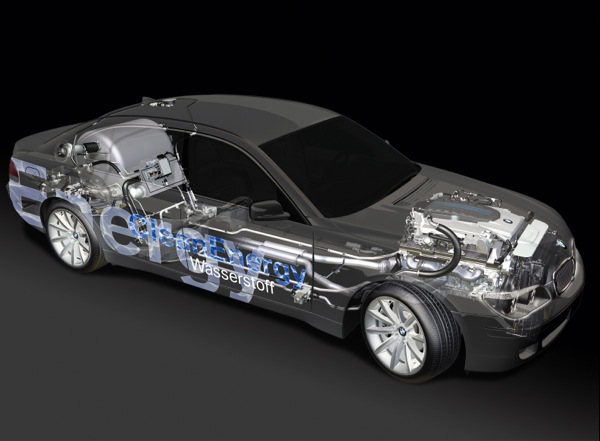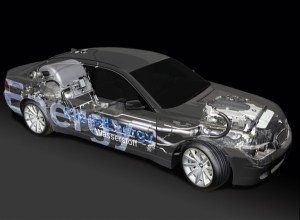 Alternative fuels such as E85 and biodiesel that were once considered fringe fuels are now mainstream. You can burn any mixture of gasoline and E85 in any vehicle that is Flex Fuel capable. As for biodiesel, blends ranging from B05 (5% biodiesel) to B100 (100% biodiesel) are being used in all kinds of diesel applications. So what other alternative fuels are being considered today?
Alternative fuels such as E85 and biodiesel that were once considered fringe fuels are now mainstream. You can burn any mixture of gasoline and E85 in any vehicle that is Flex Fuel capable. As for biodiesel, blends ranging from B05 (5% biodiesel) to B100 (100% biodiesel) are being used in all kinds of diesel applications. So what other alternative fuels are being considered today?
The front runners right now are natural gas and propane. Thanks to fracking, natural gas is plentiful and relatively cheap. Natural gas has long been used as an alternative fuel by some fleets (such as utility companies, waste haulers, buses and municipal vehicles), but it appears now to be moving toward a wider market. In 2013, natural gas provided the go power for only a small fraction of the vehicle population (less than 1 percent). The U.S. Department of Energy says there are about 112,000 natural gas powered vehicles on the road in this country.
Most of the vehicles that burn natural gas have to be specially converted from gasoline or diesel to burn the gaseous fuel. General Motors, Ford and Chrysler all offer “bi-fuel” pickup trucks that have a dual fuel capability so they can burn either natural gas or diesel. The only passenger car currently available with a natural gas option is the Honda Civic, but that may be changing soon as more and more auto makers are looking at offering natural gas versions of their cars and trucks in the U.S. market. Some of these would be straight natural gas while others would be dual fuel gasoline/natural gas or diesel/natural gas. At the recent Tokyo Auto Show, Mazda unveiled a natural gas powered Mazda3 concept car. The car has a dual fuel system that reportedly gets 20% better mileage when running on natural gas. The Skyactiv 2.0L engine has a 14:1 compression ratio, so it works very well with natural gas.
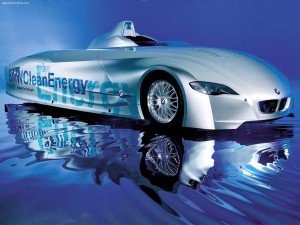
Advantages
Why natural gas? It’s cheaper and cleaner than gasoline or diesel fuel, and it burns much cleaner in a diesel engine than diesel fuel. Natural gas produces lower carbon emissions (about 20 to 25% less than diesel) and contains no sulfur. Natural gas currently sells for a gasoline-equivalent price of $1.95 per gallon, making it a third less expensive to burn as a motor vehicle fuel. In Europe, Asia and even South America, natural gas vehicles are relatively common (over 14.8 million vehicles worldwide according to the DOE). Many see natural gas as a major component in our future energy plans, and a better option than using food-based renewable fuels such as ethanol made from corn or biodiesel made from soybeans.
One application that may soon see greater use of natural gas as an alternative fuel is big Class 8 over-the-road 18-wheel heavy-duty trucks. In fact, according to the DOE, if all Class 7 and 8 trucks were converted to CNG or LNG, it would reduce our nation’s appetite for oil by 14%.
Natural gas has long been used as an alternative fuel in stationary engines and off-road engines, but recently diesel engine manufacturers have been developing natural gas versions of engines for highway use.
Cummins recently introduced two new spark-ignited diesel engines (8.9L ISL-G and 11.9L ISX12G) that can run on either natural gas or diesel. When burning diesel, the engine can meet emission standard without a diesel particulate filter or urea aftertreatment. Cummins also has a 15-liter Westport ISX15G diesel engine that runs on a mixture of 95% natural gas and 5% diesel. Volvo is also introducing a high pressure direct injection natural gas/diesel option.
The difference in fuel mileage when burning natural gas compared to diesel can range from a 5% to 20% decrease to a 5% to 20% gain depending on the type of fuel system and the modifications to the engine that are made. When an engine is optimized for natural gas, it can deliver nearly the same fuel mileage as diesel or gasoline.
Natural gas has a very high octane rating (130 Research Octane Rating or RON) and a low cetane rating (less than 10), but burns at a slower speed and lower temperature than gasoline or diesel. Increasing the engine’s compression ratio to take advantage of its high octane rating improves thermal efficiency, while careful injection and ignition timing (when a spark is used) optimizes combustion.
The economics of burning natural gas depends on the application, and whether the engine is a factory option or an aftermarket conversion. Installing a dual fuel system on a passenger car or pickup truck can cost thousands of dollars, and on a Class 8 truck a natural gas fuel system can add tens of thousands of dollars to the cost of the truck! Even so, many say the cost savings between the price of natural gas and diesel provides a relatively quick payback as the miles add up.
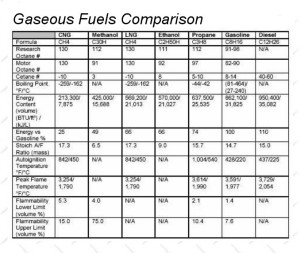
CNG & LNG
Natural gas is actually a mixture of gases, typically about 91 to 95% methane (CH4) with traces of other hydrocarbons such as propane, ethane and butane in the mix.
Historically, it has been a byproduct of oil well drilling but today it is being recovered directly by hydraulically cracking (“fracking”) gas-bearing rock formations deep below the surface of the ground. It can also be recovered from landfills and even cow farts!
Natural gas can be used as an alternative motor fuel in either gasoline or diesel-powered vehicles as Compressed Natural Gas (CNG) or Liquefied Natural Gas (LNG). Methane is a low pressure gas at room temperature. Since it is already vaporized, it mixes well with air when injected into an engine via a spray nozzle or dual feed injectors. However, for natural gas to be stored in a fuel tank, it must first be compressed or chilled and liquefied to increase its density. When compressed, it is typically stored inside a reinforced fuel tank at 3,000 to 3,600 PSI. When liquefied, it is chilled down to minus 260 degrees F (-162 degrees C) and held in an insulated cryogenic tank.
CNG is typically used in applications where vehicles travel less than 200 miles in a day and return to a central location for refueling. Centralized refueling works well for local delivery fleets, buses, cabs and municipal vehicles that are running on CNG or LNG, but a dedicated natural gas vehicle usually lacks the range of a more conventional fuel — and public CNG/LNG refueling stations can be hard to find in many areas. For longer range driving, LNG is a better option because it is much more dense when it is chilled and condensed into a liquid. This allows a greater quantity of fuel to be stored on the vehicle for an extended driving range.
Public CNG and LNG refueling facilities are available across the country (about 1,500 of them and growing), but that’s still only about 1% of all retail fuel outlets. Many more will have to be added before natural gas can become a mainstream alternative fuel. This will require a major investment in refueling infrastructure. Adding CNG or LNG capabilities to a new or existing filling station costs about half a million dollars according to the National Association of Convenience Stores. A listing of alternative fuel stations can be found at www.energy.gov.
One of the advantages of using CNG as a motor fuel in a private vehicle is that the vehicle can be refueled in a home garage if the home has a natural gas line for the furnace, stove and water heater. A home garage high pressure CNG refueling pump costs about $4,000, which is nearly two to three times the price of a 240 volt home charging station for a plug-in Chevy Volt hybrid or Nissan Leaf electric car.
Fuel Tanks
CNG and LNG fuel tanks are bulky and expensive, though not much heavier than a conventional fuel tank in most vehicles. Because of the size limitations, fuel storage capacity and range are not as great as with a conventional fuel — which can create range anxiety if a vehicle has a single fuel system that runs on CNG only. Trucks have more cargo space and can usually accommodate much larger fuel tanks, giving them more range on CNG or LNG. The other option is to have a dual fuel system that allows the engine to run on natural gas or a conventional fuel depending on which is available.
Refueling takes somewhat longer than filling a vehicle with gasoline or diesel, and requires special hose connections, fittings and dispensing equipment (a high pressure compressor or a cryogenic storage tank). Safety may be a concern with high pressure CNG or super cold LNG, but if there is a leak methane is lighter than air and rises and disperses quickly. It also has a much higher ignition point than gasoline or diesel, making it less of a fire hazard than conventional motor fuels.
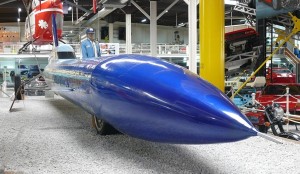
CNG As A Racing Fuel
Through CNG has long been used for ordinary everyday driving and to power stationary engines, it has also found a small but growing niche among racing enthusiasts. Back in 1970, a CNG fueled rocket car called the Blue Flame set a land speed record of 630 mph. The Blue Flame produced an estimated 58,000 horsepower and was the first vehicle to exceed 1000 kilometers per hour. The rocket car is on display in a museum in Germany today (which is interesting, considering the car was built and driven by an American!).
Patrick Racing has developed a natural gas powered race car for the American LeMans Series. The purpose of the Prototype Challenge natural gas race cars is to raise awareness of the performance potential of natural gas. Interest in green fuels has been growing lately, with E85 ethanol alcohol finding a niche as a less toxic alternative for methanol alcohol in circle track and drag racing. The U.S. Dept. of Energy, Environmental Protection Agency and Society of Automotive Engineers (SAE) have developed “Green Racing” guidelines to help foster development of alternative fuels that can be used in future production vehicles, to enhance energy independence and to reduce carbon emissions from motor vehicles. The Prototype Challenge cars are powered by a 6.2L Chevy LS3 engine that tuned to deliver 450 horsepower on natural gas.
At the recent Muscle Car & Corvette Nationals car show in Chicago, there was a vintage Pontiac GTO that has been converted to run on CNG. The car features an Chevy LS engine under the hood with a high pressure CNG fuel tank hidden in the trunk behind the back seat. The CNG fuel filler fitting was concealed behind the license plate in the back bumper. A very slick setup, indeed.
Propane
Another gaseous fuel that will play a growing role in transportation is propane (also called LPG for Liquified Petroleum Gas). According to the National Propane Gas Association, we have propane coming out of our ears. The U.S. became a net exporter or propane in 2010, and in 2011 propane production exceeded consumer demand for the first time ever.
Propane is a byproduct of natural gas wells and oil refining, and the abundant supply means it is cheaper than gasoline, though not as cheap as natural gas. Propane currently sells for around $2.40 to $2.50 per gallon, and is available at several thousand outlets around the country. It’s used in everything from fork lifts to buses to pickup trucks, and there are numerous companies who can do propane conversions on existing cars, trucks and other types of vehicles (a conversion typically costs about $4,000 to $6,500 depending on the application). Currently, there are about 160,000 propane-powered vehicles in the U.S., and more than 13 million worldwide.
Propane’s chemical formula is C3H8 so it contains less carbon than gasoline. That makes it a cleaner burning fuel than gasoline and more ecofriendly, but it also contains less heat energy per gallon than gasoline (91,000 BTUs for propane versus 115,400 for gasoline), but on a pound per pound basis propane contains more heat energy than gasoline (19,750 BTUs versus 18,970 BTUs for gasoline). Because of this, most engines develop about the same amount of power with propane or gasoline unless the engine is optimized with a higher compression ratio to take advantage of propane’s higher octane rating (112 RON). When higher compression ratios are used, propane will produce more power.
Like natural gas, propane is a vapor at room temperature. But unlike natural gas, it can be liquefied if chilled to minus 44 degrees F, or compressed and held under pressure inside a sealed tank. It only takes about 128 PSI to keep propane in a liquid state at 80 degrees F, which is much less pressure than is required for a CNG fuel system. Consequently, propane fuel tanks have a working pressure range of 175 to 250 PSI.
Propane is available in various grades for various purposes. The version that is used for motor fuel is HD5, which contains 90 percent propane, plus small amounts of butane, methane and propylene. Propane burns similar to gasoline and requires a slightly leaner air/fuel ratio of 15.7 to 1 (versus 14.7 to 1 for gasoline). Propane mixes with air readily but can be slow to vaporize at subzero temperatures. Because of this, a tank warmer may be required to deliver fuel vapor to the engine during cold weather.
Propane can be used in a single fuel or dual fuel system on a gasoline or diesel engine. Engines burning propane typically run much cleaner than gasoline or diesel engines, so valves stay cleaner and the oil lasts longer. Motor oils with special additive packages for propane are usually recommended.

Hydrogen
Another gaseous fuel that can be burned in an internal combustion engine is hydrogen gas (H2). It’s the lightest and most abundant element on Earth, but it has to be made from something else such as methane, methanol, coal or even water (via electrolysis). Because it has to be extracted from something else, production costs make hydrogen expensive (about $4 a gallon gasoline equivalent).
Hydrogen is the cleanest of all alternative fuels, producing only water vapor when it burns. It contains no carbon so there are zero carbon monoxide (CO), carbon dioxide (CO2) or hydrocarbon (HC) emissions. However, oxides of nitrogen (NOx) can still be produced as a byproduct of high combustion temperatures. Even so, EGR and a catalytic converter can clean up any NOx in the exhaust, leaving only steam coming out of the tailpipe.
Because hydrogen is a gas at room temperature, it displaces air if it is fed into the intake manifold by a throttle body spray nozzle or individual port injectors. This can cause a loss of engine power of up to 20%. By using direct injectors to deliver hydrogen directly into the combustion chamber, and by increasing the engine’s compression ratio to take advantage of hydrogen’s high octane rating (130 ROM), engine power can actually be increased as much as 15 to 20% over gasoline. Add a turbocharger or supercharger to cram more air into the cylinders, and hydrogen can fuel a real screamer!
Like natural gas and propane, hydrogen must be highly compressed or liquefied and held in a high pressure or cryogenic fuel tank. Typical storage pressures for hydrogen can be as high as 10,000 PSI! To liquefy hydrogen, it has to be chilled down to -423 degrees F (-253 degrees C)! Hydrogen can be stored at room temperature and low pressure by using other materials to absorb it like a sponge. These include metal hydrides and even charred chicken feathers or corn cobs (no joke!).
By volume, hydrogen has a very low volumetric energy density, only about one third that of natural gas. On the other hand, by weight it has 3X the energy density of gasoline. That’s why rocket fuel is often liquid hydrogen and liquid oxygen. You can get a lot of bang for the buck when you burn hydrogen. When used as a motor fuel in an internal combustion engine, hydrogen can run very lean (stoichiometric for hydrogen is 34.3 to 1).
Auto makers have been experimenting with hydrogen internal combustion engines for years. BMW has built a number of hydrogen-powered cars, including a H2R concept car and a dual fuel luxury sedan called the Hydrogen 7 KE. The latter sports a V12 engine that can run on gasoline or hydrogen. The BMW Hydrogen 7 KE gets about 17 mpg on gasoline but only about 5 mpg on hydrogen. Why such a difference? The engine was not optimized for hydrogen and it lacks a turbocharger or supercharger to take full advantage of hydrogen’s higher octane rating. With a 45 gallon cryogenic fuel tank, the car’s range on hydrogen is only about 100 miles.
Most of the interest in hydrogen these days is going towards developing hydrogen fuel cell electric vehicles. When hydrogen gas is fed into a fuel cell, the platinum catalyst inside the fuel cell causes the hydrogen to react with oxygen to make electricity. It works better than trying to power an electric car with a battery, and it delivers much high fuel economy (say 60 to 70 miles per gallon!). But so far fuel cells have been very expensive and temperamental. A fuel cell produces a lot of waste heat that has to be carefully managed with cooling fans. If the cell overheats, it can be damaged.
General Motors, Honda and other auto makers have been driving fuel cell test cars for years. Recently, I drove a hydrogen fuel cell Chevy Equinox and was amazed that it felt exactly the same as a hybrid or gasoline-powered vehicle. Toyota and Hyundai have both announced that they will start selling production-ready hydrogen fuel cell cars next year, even though there isn’t much infrastructure yet for refueling these vehicles.
Government programs are helping to fund the expansion of alternative fueling stations across the U.S., so as we move forward a greater and greater percentage of our vehicle population will be using some type of alternative fuel (CNG, LNG, LPG, hydrogen or biofuels) or an alternative energy source (plug-in electric or hydrogen fuel cell). For now, the numbers won’t be huge (only a few percent) so there will be minimal impact on engine builders who depend on the internal combustion engine for their livelihood. But even as the numbers grow, it will create new markets for servicing the engines and powertrains of the alternative fueled vehicles of tomorrow.

